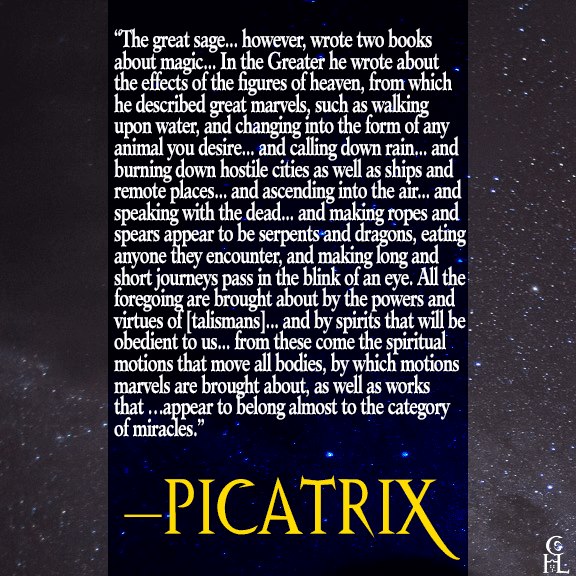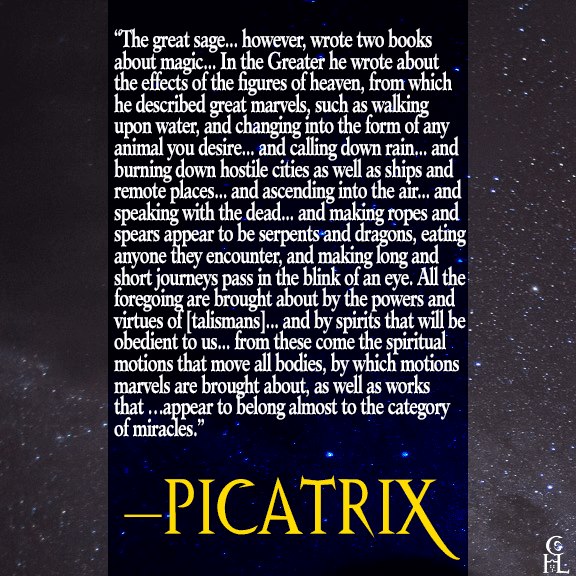
Scholastic Image Magic or SIM was one of two main branches of magical practice in the Medieval Era and the Renaissance. It was heavily influenced by the science of the Arabic world, and incorporated astrology, optics, mathematics, and the philosophy of antiquity. The European version was an outgrowth of Medieval Scholasticism; a movement which attempted to reconcile Christianity with the works of Plato, Aristotle and the mystical Neoplatonists.
Scholastic Image Magic focuses primarily upon the creation of talismans; objects created or modified to become repositories of celestial light which alter the attributes and destinies and basic nature of anything in their proximity, including human beings.
It also includes celestial petitions, which are akin to highly ritualized prayers which facilitate the granting of expressed wishes. This is where Scholastic Image Magic and theurgy, the other main branch, cross over.
(The other branch is also sometimes called necromancy, depending on emphasis. It largely focuses on angel magic and spirit evocation, and use of Biblical charms and sometimes variants of Kabbalah. There is significant overlap, but the rationales for these traditions are different at heart.)
Both the creation of talismans and the making of petitions are endowed power largely through astrological timing. Some have asserted that Scholastic Image Magic is a subcategory of Electional Astrology, the choosing of fortunate times. It certainly is dependent upon it; but I and others believe in the importance of the materials used as well. There is no way to become minimally competent in this tradition of magic without being very skilled in Medieval or Renaissance Era Astrology.
Scholastic Image Magic may also include the creation of confections, suffumigations (incenses), and potions; though these are often considered to be alchemy.
Many of us who have experimented with Scholastic Image Magic believe it to be the most powerful (and sometimes dangerous) form of magic in Western history. The demands usually exceed those of other magical traditions in numerous ways, and the results are proportional. It is not for the dilettante. Many of us have studied under Christopher Warnock, whose RenaissanceAstrology.com is a great place to learn a major flavor of this from tabula rasa. Without having some background in the generalities of Traditional Astrology you’ll probably be very confused. John Michael Greer often describes this stuff as the rocket science of the Middle Ages. (And he should know, because he translated Picatrix with Christopher Warnock a few years back.)
Scholastic Image Magic has a body of literature which we refer to frequently. The most central text is the Picatrix, which has two popular editions at present. Another, harder to find text is the Treasure of Alexander. Cornelius Agrippa’s Three Books on Occult Philosophy (especially the upcoming complete Eric Purdue translation) is an excellent source for Scholastic Image Magic and much else besides, and large portions of the somewhat derivative The Magus from Francis Barrett are appropriate. Though the available version of De Imaginibus is purged of suffumigation recipes and incantations, it is still of great value. I find the Liber Lunae to be very fascinating, and has had an influence on Kabbalah. The Mysterium Sigillorum and the Kyranides have content of interest. Many shorter texts such as the Quindecim Stellis and De Mineralibus, Seals & Stones of Solomon, Seals & Sigils of Chael, Talismans of Hermes, and the Seals of Thetel are also very important, and sections of the works of Giordano Bruno and even parts of the so-called Greater Key of Solomon merit study. But all of this is built upon a foundation of antique astrology and metaphysics, such as the essential writers Guido Bonatti, Johannes Sacrobosco, and Abu Yusuf Al-Kindi, which the authors expected the readers to have expertise in.
I have studied and practiced Scholastic Image Magic in a very focused way for over a decade, I have witnessed it cure incurable diseases, draw hundreds of thousands of dollars from nowhere, conjure storms, raise and banish spirits, repel dangerous animals, hypnotize and compel obedience, and make a subject fall hopelessly in love. In my own experience it is vastly closer to the kind of magic which appears in myths and Fantasy literature than anything else I’ve seen. (And I have expertise in many other traditions of magic, which have their own distinctive advantages.)
If this tickles your fancy and you’re considering putting in the effort, welcome aboard. SIM is one of my very favorite flavors of magic. If it isn’t your cup of tea, there’s a lot of additional material on my blog to inform and tantalize.


Leave a Reply